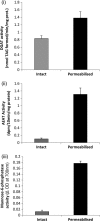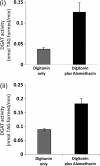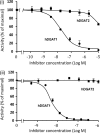Evidence that diacylglycerol acyltransferase 1 (DGAT1) has dual membrane topology in the endoplasmic reticulum of HepG2 cells
- PMID: 21846726
- PMCID: PMC3196132
- DOI: 10.1074/jbc.M111.251900
Evidence that diacylglycerol acyltransferase 1 (DGAT1) has dual membrane topology in the endoplasmic reticulum of HepG2 cells
Abstract
Triacylglycerol (TAG) synthesis and secretion are important functions of the liver that have major impacts on health, as overaccumulation of TAG within the liver (steatosis) or hypersecretion of TAG within very low density lipoproteins (VLDL) both have deleterious metabolic consequences. Two diacylglycerol acyltransferases (DGATs 1 and 2) can catalyze the final step in the synthesis of TAG from diacylglycerol, which has been suggested to play an important role in the transfer of the glyceride moiety across the endoplasmic reticular membrane for (re)synthesis of TAG on the lumenal aspect of the endoplasmic reticular (ER) membrane (Owen, M., Corstorphine, C. C., and Zammit, V. A. (1997) Biochem. J. 323, 17-21). Recent topographical studies suggested that the oligomeric enzyme DGAT1 is exclusively lumen facing (latent) in the ER membrane. By contrast, in the present study, using two specific inhibitors of human DGAT1, we present evidence that DGAT1 has a dual topology within the ER of HepG2 cells, with approximately equal DGAT1 activities exposed on the cytosolic and lumenal aspects of the ER membrane. This was confirmed by the observation of the loss of both overt (partial) and latent (total) DGAT activity in microsomes prepared from livers of Dgat1(-/-) mice. Conformational differences between DGAT1 molecules having the different topologies were indicated by the markedly disparate sensitivities of the overt DGAT1 to one of the inhibitors. These data suggest that DGAT1 belongs to the family of oligomeric membrane proteins that adopt a dual membrane topology.
Figures








Similar articles
-
Hepatic VLDL secretion: DGAT1 determines particle size but not particle number, which can be supported entirely by DGAT2.J Lipid Res. 2019 Jan;60(1):111-120. doi: 10.1194/jlr.M089300. Epub 2018 Nov 5. J Lipid Res. 2019. PMID: 30397187 Free PMC article.
-
Differential effects of fenofibrate or simvastatin treatment of rats on hepatic microsomal overt and latent diacylglycerol acyltransferase activities.Diabetes. 2002 Jun;51(6):1708-13. doi: 10.2337/diabetes.51.6.1708. Diabetes. 2002. PMID: 12031956
-
Overt and latent activities of diacylglycerol acytransferase in rat liver microsomes: possible roles in very-low-density lipoprotein triacylglycerol secretion.Biochem J. 1997 Apr 1;323 ( Pt 1)(Pt 1):17-21. doi: 10.1042/bj3230017. Biochem J. 1997. PMID: 9173878 Free PMC article.
-
Role of DGAT enzymes in triacylglycerol metabolism.Arch Biochem Biophys. 2018 Oct 1;655:1-11. doi: 10.1016/j.abb.2018.08.001. Epub 2018 Aug 3. Arch Biochem Biophys. 2018. PMID: 30077544 Review.
-
[Progress in the study on diacylgycerol acyltransferase (DGAT)-related genes].Yi Chuan Xue Bao. 2005 Dec;32(12):1327-32. Yi Chuan Xue Bao. 2005. PMID: 16459663 Review. Chinese.
Cited by
-
Symposium review: Intravital imaging of the lactating mammary gland in live mice reveals novel aspects of milk-lipid secretion.J Dairy Sci. 2019 Mar;102(3):2760-2782. doi: 10.3168/jds.2018-15459. Epub 2018 Nov 22. J Dairy Sci. 2019. PMID: 30471915 Free PMC article.
-
Monoacylglycerol acyltransferase-2 is a tetrameric enzyme that selectively heterodimerizes with diacylglycerol acyltransferase-1.J Biol Chem. 2014 Apr 11;289(15):10909-10918. doi: 10.1074/jbc.M113.530022. Epub 2014 Feb 25. J Biol Chem. 2014. PMID: 24573674 Free PMC article.
-
Synergistic mechanisms of DGAT and PDAT in shaping triacylglycerol diversity: evolutionary insights and metabolic engineering strategies.Front Plant Sci. 2025 Jul 1;16:1598815. doi: 10.3389/fpls.2025.1598815. eCollection 2025. Front Plant Sci. 2025. PMID: 40666298 Free PMC article. Review.
-
An alternative angiosperm DGAT1 topology and potential motifs in the N-terminus.Front Plant Sci. 2022 Sep 16;13:951389. doi: 10.3389/fpls.2022.951389. eCollection 2022. Front Plant Sci. 2022. PMID: 36186081 Free PMC article.
-
Hepatic VLDL secretion: DGAT1 determines particle size but not particle number, which can be supported entirely by DGAT2.J Lipid Res. 2019 Jan;60(1):111-120. doi: 10.1194/jlr.M089300. Epub 2018 Nov 5. J Lipid Res. 2019. PMID: 30397187 Free PMC article.
References
Publication types
MeSH terms
Substances
Grants and funding
LinkOut - more resources
Full Text Sources

